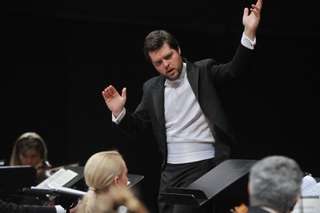|
Back
Orchestre symphonique Dazzles with Tetzlaff and Valcuha Montreal
Maison symphonique de Montréal, Place des Arts
11/04/2014 - & November 6*, 2014
Modeste Mussorgsky: Night on Bald Mountain (Orch. N. Rimsky-Korsakov)
Karol Szymanowski: Violin Concerto No. 1, Op. 35
Sergei Rachmaninoff: Symphonic Dances, Op. 45
Christian Tetzlaff (Violin)
Orchestre symphonique de Montréal, Juraj Valcuha, (Conductor)

J. Valcuha (Courtesy of OSM)
The young, dynamic Slovakian conductor Juraj Valcuha led the Orchestre symphonique de Montréal (OSM) on Thursday evening in a program of three Eastern European romantic works. The concert was entitled “Moussorgsky & Rachmaninoff” but the main draw was Christian Tetzlaff playing Szymanowski’s rarely performed and fiendishly-difficult Violin Concerto No. 1. Tetzlaff, one of the finest violinists of his generation, and the OSM delivered a sumptuous, mesmerizing performance. He and the orchestra were united in perfect harmony. The impressionistic, single movement work had an expansive quality that seemed other-worldly. Tetzlaff’s playing was faultless—perfect pitch, honeyed-tone, effortless technique, and seamless changes in dynamics. Valèuha consistently maintained an even balance between the orchestra and soloist, drew lush colors and ethereal sounds from the orchestra, and sustained hand-in-glove control of phrasing and dynamics. All sections of the orchestra performed exemplarily.
The concert opened with Mussorgsky’s short tone poem Night on Bald Mountain in the 1886 orchestration by Rimsky-Korsakov. Valcuha brought verve and excitement to the reading, with tight playing from the woodwinds, even intonation from the brass, sustained rhythms from the basses, and a delicate “duet” between the strings and solo trumpet in the denouement. He applied a restrained, poetic touch to the hushed conclusion.
The relatively short concert (95 minutes including intermission) concluded with Rachmaninoff’s last work, the Symphonic Dances, Op. 45. The performance was as fine as those of the first two works on the program. In addition, several factors that the works shared may have contributed to the consistent quality of the performances. They all use full orchestral forces, allowing plenty of opportunities for each section and individual musician to show their best; they all feature riveting, ecstatic, dance themes; they all use one or two harps; and two use a piano. As an additional treat, the Rachmaninoff also featured an instrument rarely heard in classical music—the saxophone, played with melancholic warmth by André Moisan. Other delights included the sustained low note from the bottom of the contrabassoon’s range near the end of the first dance; the rich, velvety solo from concertmaster Richard Roberts in the second; and the trilling orchestration of the composer’s beloved Dies irae in the third. Overall, the high quality of the three performances made for a memorable evening.
Earl Arthur Love
|